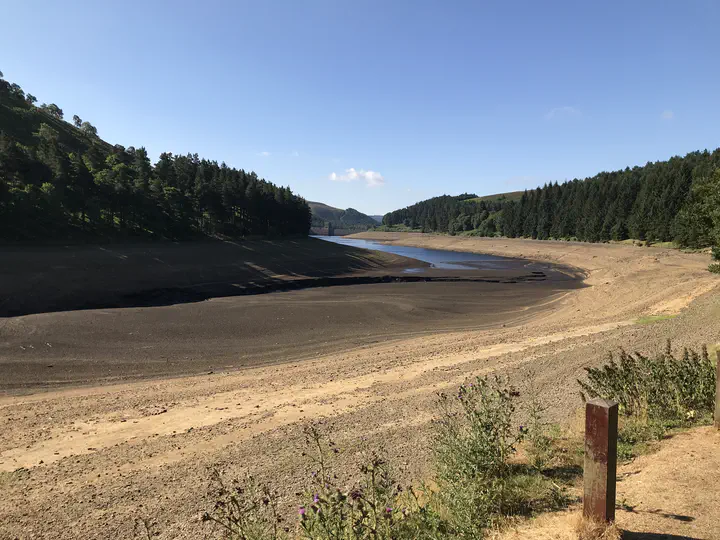Why is the UK still in a drought?

Dr Anna Murgatroyd explains that safeguarding water systems against climate change requires understanding of emerging climate risks and strategic planning of water supplies. In our recent paper, we use a coupled simulation model to assess the reliability of public water supplies in England, in the context of changing scenarios of water demand, water regulation and climate change.
Figure 1. Howden Reservoir during the 2018 drought. Credit: Katie Muchan, CEH, About Drought Programme.
Listen to Dr Anna Murgatroyd’s recent podcast on drought in the UK, hosted by Oxford Sparks.
It is becoming increasingly common to read about the catastrophic impacts of drought around the world. One of the most serious impacts of drought is upon public water supplies. These are the supplies of treated water to homes and businesses that are relied upon for human consumption, hygiene and other essential services worldwide.
England and Wales have experienced several severe droughts over the past 200 years, and are increasingly confronted with conditions experienced in drier regions elsewhere in the world. Historic droughts have had significant impacts, such as failure of crops, environmental damage, wildfires and restrictions on water use by businesses and households. The 1975-76 drought is considered one of England’s most severe droughts, with low river flows occurring across the county and standpipes implemented in areas experiencing water shortages.
Widespread drought this year prompted water companies around England to impose water-use bans and emergency drought orders, banning people from using hosepipes to wash cars, water gardens or fill paddling pools. If we have another dry winter, with lower than normal rainfall, water users will likely experience the same bans next year.
How to deal with droughts is a debate that’s heating up as the impacts of climate change are more acutely understood. The most recent IPCC report indicated that climate impacts on water security will likely worsen into the future, presenting a significant threat to drinking water supply and sanitation services worldwide.
Safeguarding water systems against climate change requires understanding of emerging climate risks and strategic planning of water supplies. Identifying the best adaptation actions for individual water systems, based on our improved understanding of climate risks, requires carefully crafted decision-making tools. Water system simulation modelling is a tool which can be used to do this, helping to understand, map and plan for risks to water supply. Simulation answers the ‘what if’ questions of planning. It allows us to track water as it moves from water source to water user. Models use historic observations or forecasts of rainfall, river flows and water use to guide simulations, allowing us to analyse how water supplies may change into the future. Simulation models can also be used to inform the operation of large water supply infrastructure, helping to keep water flowing during periods of water scarcity.
In our recent paper, we use a coupled simulation model to assess the reliability of public water supplies in England, in the context of changing scenarios of water demand, water regulation and climate change. The coupled simulation model combines climate simulations, a national-scale hydrological model and a national-scale water resource systems model to demonstrate how extreme meteorological droughts translate into hydrological droughts and water shortages for water users. We use this model to explore the effectiveness of strategic water resource options that are being planned in England to secure water supplies to most of England’s population up to a drought return period of 1 in 500 years.
We conclude that it is possible to achieve a 1 in 500 year standard in locations where strategic resource options are utilised, even whilst also reducing abstraction pressure in certain locations to restore a balance between environmental and human needs for water. However, the target will be easier to achieve if effective steps are also taken to reduce water demand.
Read the paper here.